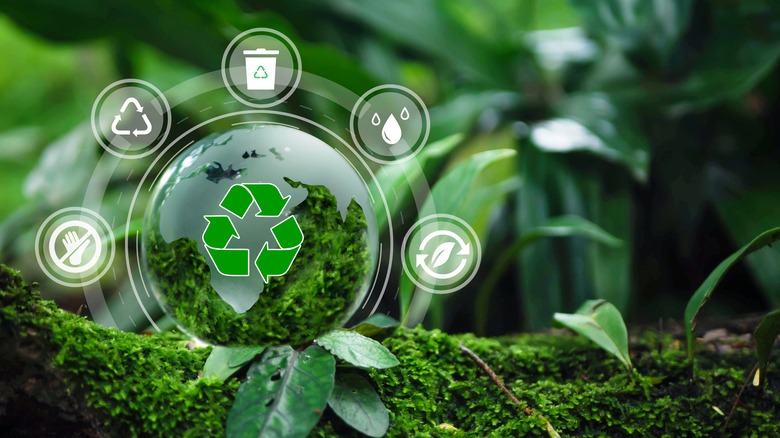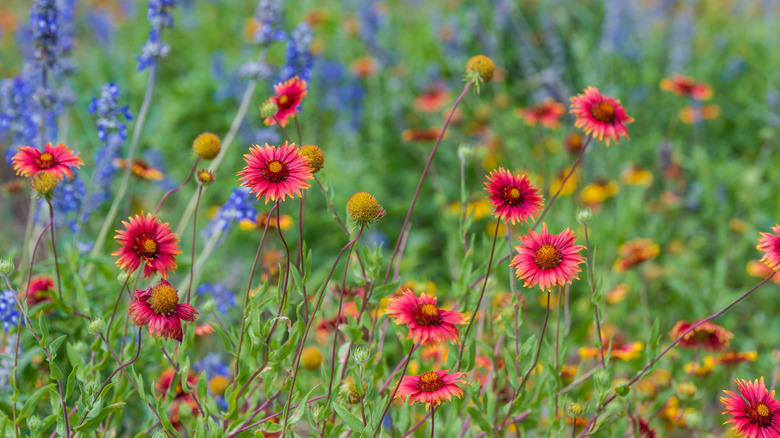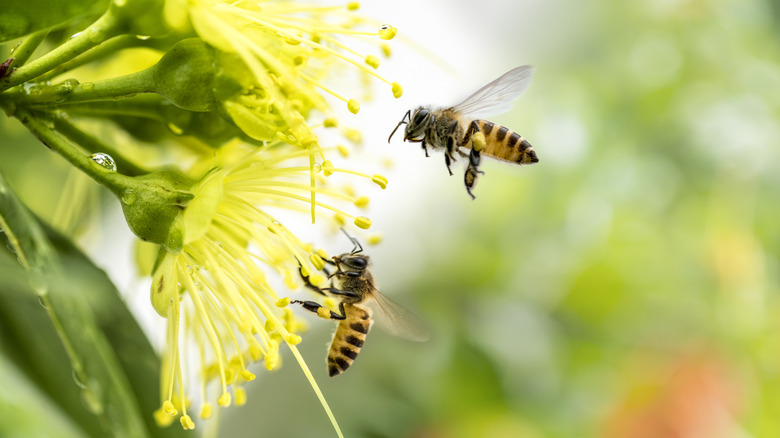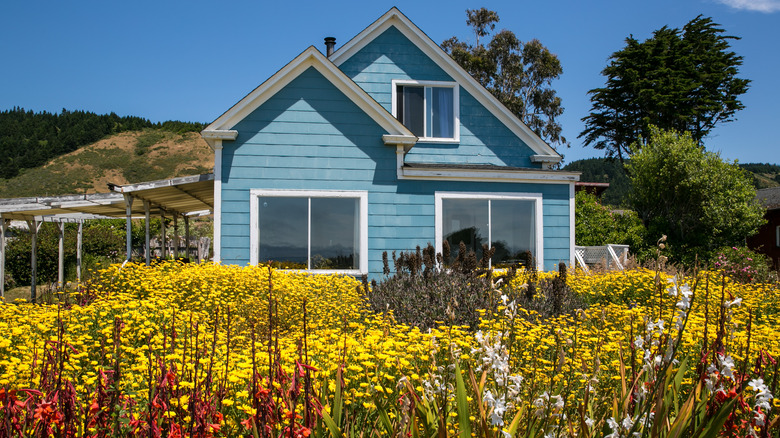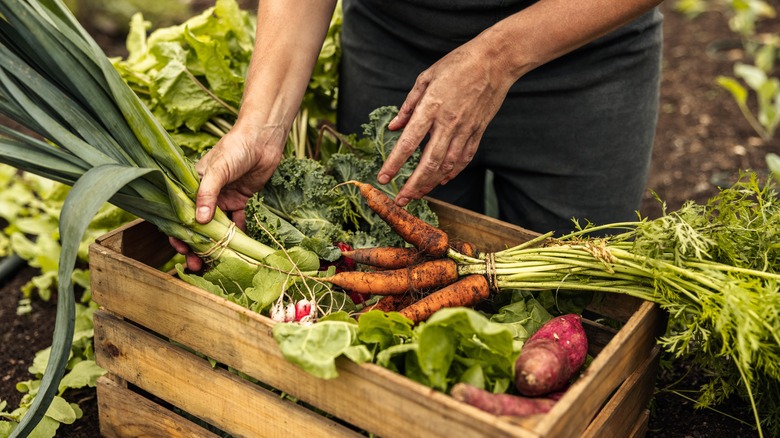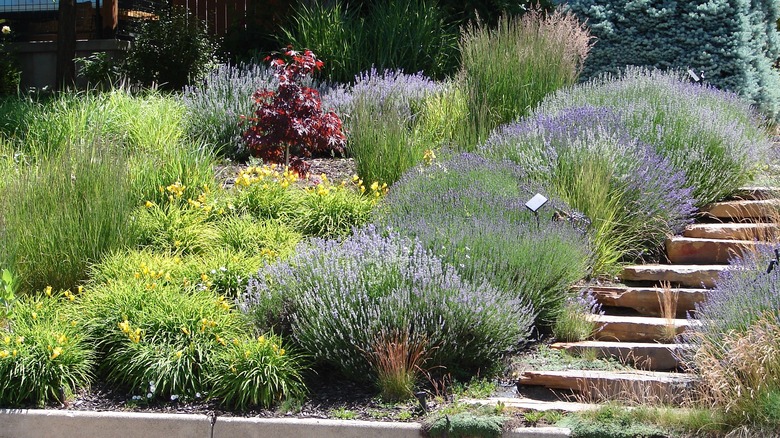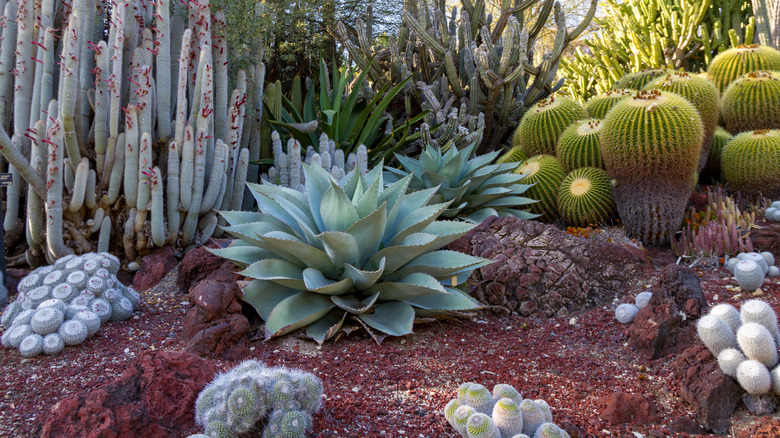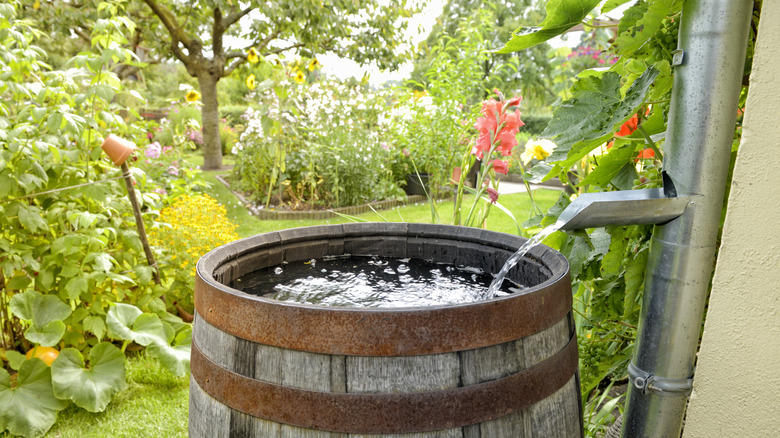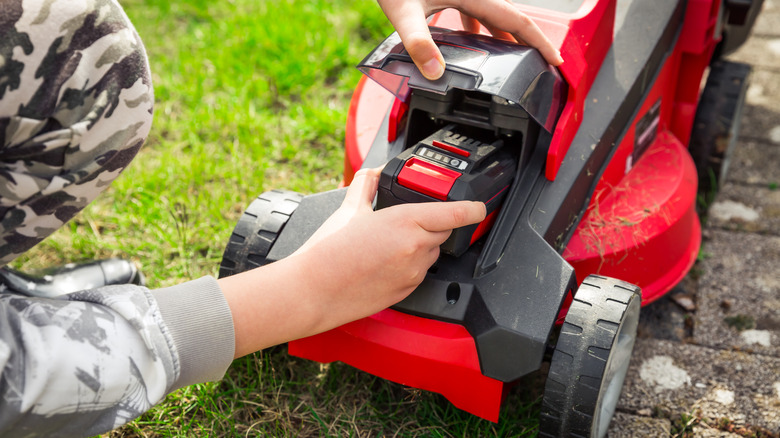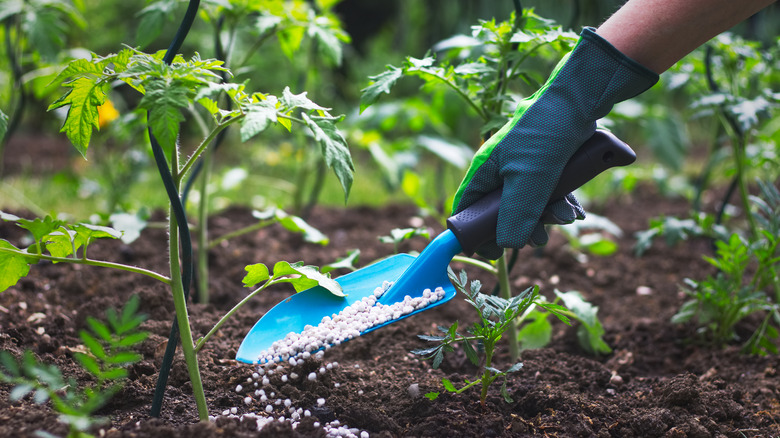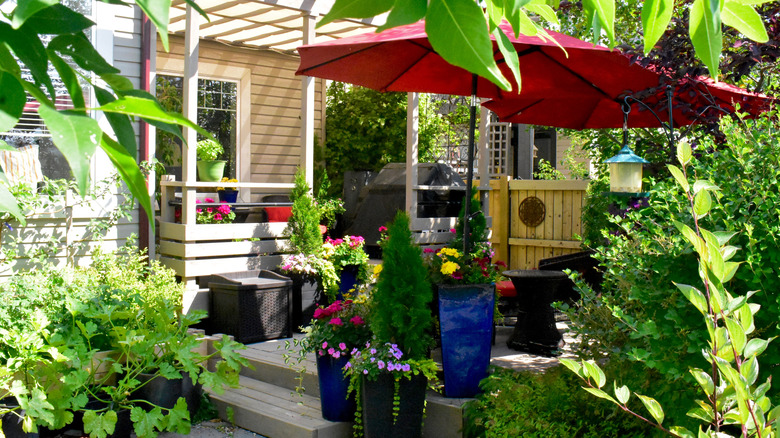Climate-Conscious Gardening: What It Is And How To Implement It In Your Garden
Gardening, for the most part, is an environmentally positive endeavor. Plants absorb carbon dioxide (the number one greenhouse gas emitted in the U.S.) and release oxygen. Gardens feed and support beneficial pollinators, some of whom are endangered and really need the help. And the simple act of growing your own food helps to reduce your individual carbon footprint on the world. In some cases, gardening can become a less than eco-friendly pursuit. Piling on fertilizers, accidentally planting invasive species, stressing tapped water sources, and using fossil fuel burning equipment like lawnmowers and tillers are just a few of the ways our gardening hobby can take an unexpected left turn.
These issues on the small scale combined with the negative global effects of climate change can leave us wondering if we'll ever get it right, yet there may be a light at the end of the dark tunnel. In her book "The Climate Conscious Gardener," Janet Marinelli says, "Gardeners, with their intimate connection to the natural world, have a unique opportunity to demonstrate how to transform concern over climate change into effective action," (via Brooklyn Botanic Garden). She continues, noting that "gardeners have the potential to do more than reduce their greenhouse gas emissions."
This is because photosynthesis in plants does such a remarkable job of removing carbon dioxide from the air and turning it into useful energy. "As plants grow," explains Marinelli, "carbon is stored in their living tissue and remains there over their lifetime, which in many trees can be considerable. This means it is possible to create a garden that is carbon negative — that captures more carbon than it emits in carbon dioxide and its equivalent of other greenhouse gases." Here are some of the best ways you can get started.
Plant native & climate-adaptive species
You can ease yourself into climate-conscious gardening by starting with the plants you choose to cultivate. We all know that desire to grow a bird of paradise in our arid or sub-zero climate zone after returning home from a tropical vacation. When that urge strikes, all we really need to do is keep the non-native species inside as a houseplant. When it comes to our outdoor gardens and landscapes, going native according to our natural environment is one of the best things we can do because these types of plants usually need less fertilizer to stay healthy and even less water. Beyond their ease of care, they're also the plants that local wildlife relies upon for food and shelter.
More problematic than a single non-native species is a single invasive species. These plants compete against and have the potential to choke out native plants, and they usually cannot be consumed by resident wildlife. Furthermore, invasive species tend to spread quickly and are difficult and expensive to eradicate. To learn more about which species are invasive in your area, check out the USDA National Invasive Species Information Center. Once you've learned exactly what not to grow, head over to your local extension service for an education in all the plants that naturally thrive where you live. Native species will be gorgeous, easy to tend, and have the least detrimental effects on your yard.
Become a pollinator destination
The next step in optimal plant choices for climate-conscious gardening is to focus on those that attract and sustain pollinators. The significance of pollinators on the health of our planet cannot be overstated. Not only do 75% of all flowers around the globe depend on them, but close to 35% of food crops around the world do as well. As the USDA succinctly puts it, that accounts for pollinators helping to produce every third bite of food we eat!
Even a small container garden on a back porch can improve the future for these vital workers. Hummingbirds, for instance, are well known for being creatures of habit who can remember the exact location of a feeder and return to it on a yearly basis as they migrate back and forth, explains Hummingbird Central. What seems like a trivial delight outside our kitchen windows proves to be a lifesaver to a bird flying solo for 500 miles from the Yucatan to Florida. To get started with pollinator-friendly plants in your garden, seek out native wildflowers and be sure to add milkweed to the mix. Include early spring bloomers like hyacinth as well as a few flowers that will bloom late into autumn such as goldenrods and asters. For more inspiration about which plants are best for your area, Pollinator Partnership offers a handy tool that allows you to enter your zip code (or postal code for those living in Canada), which will lead you to a downloadable PDF full of pollinator information specific to your region.
Rewild, ungarden, and meadowscape
Three of the hippest new terms on the gardening block are rewilding, ungardening, and meadowscaping. They have a lot in common — and actually might all be the same exact thing, come to think of it — so we'll tackle them together here. The basic idea is to forgo the perfectly manicured lawns of old and, instead, embrace the bounty of nature as your local ecology intended. You can think of it as handing over your yard to Mother Nature, the ultimate gardening expert. You'll still have a little management work to do in terms of weeding and edging, but for the most part, you'll be letting nature retake its course as you kiss your grass goodbye.
Something important to consider if you work towards rewilding and meadowscaping with wildflowers and native shrubs galore is that these are the flora that bid a warm welcome to your local fauna. That's a big part of the deal; you will see more wildlife come into your yard than before, and they'll be settling in for the long haul. It's perfectly normal to be squeamish about woodchucks, voles, foxes, and more calling your hedge home. Be honest with yourself before heading down this road and don't feel bad if ungardening is, ultimately, not the climate-conscious step you want to take. There are plenty of other things you can do. On the other hand, if all you ever wanted was to watch an adorable family of rabbits shamelessly munching on your coneflowers in the bright sun, then this might be the trend for you.
Sustainably grow organic and climate-conscious foods
The term climate-conscious food refers to any type of food grown in a way that is sustainable over the long term and has a limited effect on the land. Of course, this means the fruits and vegetables we're accustomed to growing in our backyard gardens, but it also encompasses mushrooms, seeds, nuts, and grains, many of which you can grow just as easily as your prized tomatoes. The more you attempt to grow at home, the less you buy at the grocery store, further decreasing your carbon footprint.
Naturally, the larger your operation, the trickier it gets. Small-scale farms and community gardens can apply for USDA organic certification, but the process is costly, time-consuming, and not always worth the tremendous effort required. In a 2014 interview with Bloomberg, Jennifer LaMonica of Sea Salt CSA said, "We didn't need the certification for our customers to feel confident that we were giving them quality produce. When we dropped the [organic] label, we had their support." Almost a decade later, this still rings true for many small local farms.
There are other types of certifications to consider such as Certified Naturally Grown and Bee Better certification from the Xerces Society. At the end of the day, do the best you can by learning beneficial practices from these certifiers that you can put into practice at home. If that means organic seeds planted into organic garden soil you bought from the local megastore, then pat yourself on the back for a job well done and a significant step taken towards growing your own food and doing what you can to combat climate change from your own backyard. You can increase this effort by buying organic produce in the store when possible.
Xeriscape
Xeriscape roughly translates from the Greek to dry view. In essence, this is the name of a horticultural method that focuses on plants that are both slow-growing and tolerant of drought as a way to conserve water. People who live in arid desert-like environments know this type of landscape well because in their area it's a necessity unless someone wants to spend a fortune on an extensive irrigation system to maintain a tiny patch of front lawn. (No thank you!) More of us can benefit from a xeriscaped garden though. Practically speaking, anyone can see the advantage of a landscape that requires less water, even those who live in a humid climate zone. That reduction, per Cornell University Cooperative Extension, can be as much as 50 to 60% of your average usage. Climate-conscious? Obviously. It's also rather budget-conscious.
Rather than setting your plants in the ground willy-nilly, plan a layout that will group together plants with the same irrigation requirements. Situate the plants with the highest tolerance for drought away from the house and in areas that receive the most amount of harsh direct sunlight. Plants that need regular watering should be closer to the house and, therefore, closer to the garden hose. To get the most out of a xeriscaped landscape you will need to plan ahead, but one of the major benefits is extremely low maintenance once you have everything in place. Remember, these are the plants you can forget about for weeks at a time with no negative impact.
Plant low water & drought-tolerant species
A drought-tolerant garden does not mean a space full of rocks and spiky uninviting cacti, though it certainly could if that's what you're into. Furthermore, you don't have to go whole hog and xeriscape your entire backyard so you feel like you moved to the desert. Picking a few low water trees will make a difference. This could mean anything from a stunning painted maple to a 60-foot tall northern catalpa. For shrubs you could opt for a gorgeous butterfly bush (Hello, pollinators!) or a flowering rose of Sharon.
There are plenty of drought-resistant flowers that will brighten up a low water garden. Colorful bougainvillea, petunias, lantanas, and portulaca will feel right at home, as will lavender which will double as a delightfully fragrant garden addition and a climate-conscious food. Bake it into cookies or steep it into tea, then use leftover dried lavender flowers in sachets for aromatherapy around the house.
As for your edible garden, grapes, Jerusalem artichokes (sunchokes), and pomegranates are all drought-tolerant. You could also have a thriving herb garden with little water needed if you keep it to sage, thyme, rosemary, and tarragon. Once those are grouped together in the ground, perhaps installing a hydroponic herb garden in the kitchen is the way to grow the rest of the herbs you love, i.e. the ones with higher water needs. Don't forget that grasses are plants too. Pink pampas grass, blue and green fescue, purple needlegrass, and striped zebra grass are just a few of the multicolored options at your disposal.
Get creative with rainwater
Some of us live in the polar opposite of a dry arid climate — a high humidity zone — and some of us are just experiencing more rain than ever before. Excessive precipitation is an indicator of climate change, explains the U.S. Environmental Protection Agency (EPA). Forget struggling to irrigate; if you live in a region dealing with inordinate amounts of rainfall, you're probably looking for ways to avoid a flooded yard or basement. Some of these solutions can be implemented in the garden. Collecting rainwater in a barrel is a practice known as rainwater harvesting and it allows you to save the water until you can put it to use watering your plants, washing your car, scrubbing down Fido, or refilling your pool. Simply position the downspouts from the gutter system of your house so they pour runoff into a water-tight barrel or other catchment. Incorporating rain chains may prove useful as well. Providing both decorative beauty and functionality, rain chains guide gutter runoff down from the roof along chains.
On a different note, you could intentionally plant something called a rain garden. These types of green infrastructure are the true worker bees of garden layouts because they actively prevent runoff and flooding. Yes, they can look nice, but more importantly, they get the job done. By design, rain gardens are situated in depressed areas so they naturally receive excess rainfall and reabsorb it into the ground. Rain gardens do not divert water away from a structure like bioswales or underground pipes do; they act as natural filtration systems that clean the water and then send it back down to the water table where it belongs.
Go electric with power tools
Princeton University points out that lawn maintenance is directly tied to climate change due to the 40 million acres of land that are covered in grass in the U.S. and the 800 million gallons of gasoline it takes to operate mowing equipment. Yikes! Some equipment motors are worse than others because they can release toxic fumes at a rate 124 times higher than that of an idling car or truck. These are the same emissions that increase carbon dioxide levels and perpetuate global warming. This is happening to such a degree that the EPA has collected data to show that gas powered lawn mowers alone are responsible for 5% of our country's overall air pollution.
Even so, due to the unmistakably positive characteristics of gas powered tools (longevity, lower cost, no dead batteries to dispose of), the argument over what type of tools are best for the environment has yet to have crystal clear outcome. In the end, however, most agree that electric power wins out over gas (via University of Illinois Extension). Aside from lawn mowers, the most common gas powered gardening tools are trimmers, leaf blowers, and tillers (or cultivators), all of which come in electric or battery powered models.
Minimize fertilizer use and protect topsoil
Fertilizers, when used appropriately, are enormously beneficial in the growth of healthy plants. What gets us into trouble is over-fertilization, improper fertilization (picking the wrong kind), and chemical runoff into our waterways which causes algae blooms and harms fish and aquatic wildlife. Chemical runoff also negatively affects the quality of our drinking water and makes it more expensive to properly treat it for safe consumption. Reducing dependence on synthetic chemical fertilizers is one way to make a big impact on your own garden as well as the health of your local watershed.
When purchasing fertilizer for your garden there are a few things to keep in mind. First, make sure you are buying the right type of fertilizer for your needs and, whenever possible, opt for organic. Next, look for slow-release formulas. The primary benefit of slow-release fertilizer is that the soil has time to fully absorb the nutrients at this gradual pace. That translates to a reduction of excess nutrients that would have otherwise turned into toxic runoff. From there, turn to the many natural fertilizers available to us in the forms of manure, compost, bone meal, liquid seaweed, and alfalfa meal. These will contain valuable trace minerals you're unlikely to find in an all-purpose commercial fertilizer, and compositions such as fish hydroslate offer vital amino acids, enzymes, and vitamins.
Once you have a climate-conscious plan in place to fertilize your garden, work to keep that fertile topsoil intact. The Rainforest Alliance explains that the simple act of planting ground covers prevents the harmful topsoil erosion that comes from heavy rainfall. Mulch and natural weave erosion control blankets can also help in this way; as can digging trenches and planting along layered terraces.
Landscape for home energy efficiency
We strategically place shade trees throughout our backyards to create seating areas where we can take respite from the glaring sun. But did you realize you can also use those trees to shade your house and effectively lower your cooling costs? Heat from the sun will be absorbed through the roof as well as the windows, making it hotter inside and more expensive to cool. All of a sudden it makes perfect sense to think about the indoors while you're designing the layout of the outdoors.
Believe it or not, you can landscape to reduce heating bills too. Depending on the type of climate region you live in, smartly placed trees can be employed as a windbreak to deflect wind away from the house, which will lower the wind chill and make it warmer. Windbreaks should be planted away from the house so you get the most benefit from them. Thick evergreen shrubs planted along the windward side of your property will create a wall to stop snow from drifting and piling up against your home. The final piece is to make sure the shade trees you plant for that summertime cooling effect are deciduous; this way they'll shed their leaves and let the sun shine brightly on those windows to warm up the inside even more during winter.
Using these techniques to heat and cool your house is definitely worth it; Energy Saver states they could lead to 25% savings on energy costs. Don't stop at learning about the climate of your region in general. Take into account the location of your home in regard to local wind and sun. Is your home high on a hill or deep in a valley? Do you receive more sun exposure than your neighbors? All of these factors will determine ways to make your garden more climate-conscious.
